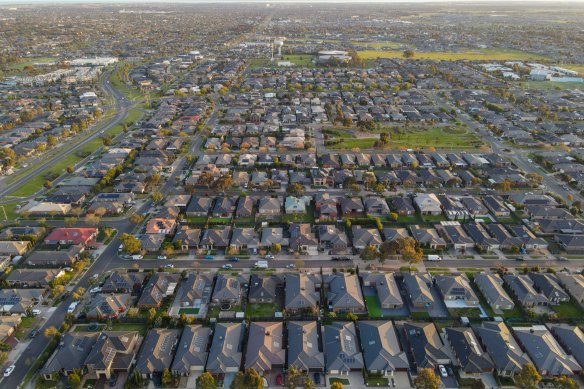Opinion
Melbourne property prices are flatlining. Has the world’s most liveable city lost its mojo?
Josh Gordon
Senior ReporterMelbourne does not have a glittering jewel of a harbour, excessive sunshine or booming surf.
Instead, we have nondescript bay, unglamorous beaches, bad weather and a brown and lazy waterway that is more or less un-swimmable.

Experts and the government agree we can’t keep expanding outwards.Credit: Alamy
But ask any self-respecting Melburnians, and they’ll tell you we have something much better: we are city that is kind to its citizens, with a functional public transport system, a flourishing creative class and decent coffee.
The idea that Melbourne is one of world’s most liveable cities has long been intrinsic to our collective consciousness. It has made us what we are, a place where people want to live.
Now, though, it seems Melbourne may be losing its mojo. Whether that’s a good or bad thing is a different question. More on that later. First, a recap.
According to data released last week by property monitoring company CoreLogic, Melbourne is no longer second to Sydney as the most expensive state capital for houses or apartments.
For the first time ever, that title has gone to Brisbane, where the median house now costs $937,479 – $190 more than Melbourne.
Over the 12 months to May, prices leapt 15.9 per cent in Brisbane, 10.3 per cent in Sydney and by 25.3 per cent in Perth. Even sleepy Adelaide recorded annual house price growth of 15.3 per cent. Yet in Melbourne, house prices limped up by just 2.4 per cent. So what’s going on?
The first and most obvious explanation is interstate migration. The sunshine state, in particular, has been the recipient of tens of thousands of arrivals from Victoria and NSW.
According to the Australian Bureau of Statistics, Queensland gained a net 170,203 people from other jurisdictions over the five years to September 2023. During the same period, Victoria lost a net 49,934 of its residents to interstate migration, while NSW lost a whopping 156,061 people.
Interstate migration has a direct and immediate impact on house prices, often prompting people to sell in one jurisdiction and quickly buy in another. In other words, there has been an extreme demand shock linked to interstate migration, against a backdrop of supply constraints, and lengthy planning and construction processes. Hence, the relative movement in prices.
But this alone doesn’t explain why prices have continued to race ahead in NSW, while the market remains soft here. Another part of the explanation can be found on the supply side.
In the lead-up to the pandemic, Victoria actually built a record number of dwellings, particularly multi-unit apartments and townhouses. Despite repeated suggestions from the state government that local councils are to blame for our state’s housing woes, many parts of Melbourne have already densified significantly.
During the 2017-18 financial year, work started on a record 75,575 dwellings in Victoria, which translates to about 11,500 for every 1 million Victorians. At the same time, NSW work started on 71,786 dwellings, equivalent to just 8969 dwellings per million people.
But the impact of the apartment boom is now fading. Despite the Allan government’s plan to build an average of 80,000 houses a year for the next decade, Victoria isn’t now building anywhere near enough to keep pace with the state’s rapid population growth, which has been entirely driven by overseas migration.
Over the year to September 2023, Victoria absorbed a net 161,758 foreign arrivals – a 30 per cent share of the national total. Despite this, the impact on house prices hasn’t been as big as you might think, with research showing overseas migrants are much more likely to rent than interstate migrants.
There is a critical difference between supply and demand for the purchase of a property and the supply and demand for rental properties. In fact, the average number of houses listed for sale is now about 12 per cent above the historic average in Melbourne, but 30 to 40 per cent lower in Brisbane, Adelaide and Perth.
Another force at work is state taxes. Victoria has the highest state government taxes on property in the nation, particularly for investors. When you throw high-interest rates and high council rates into the mix, being a property investor is becoming less attractive by the day in Victoria.
In last year’s budget, for example, the state government introduced what it called the COVID Debt Repayment Plan, which involved higher rates of land taxes for property investors. That tax rise along is expected to extract about $4.7 billion from property investors over four years.
As a consequence, property investors appear to be migrating to other jurisdictions. In April, just 30.6 per cent of new loans written in Victoria were used to purchase investment properties, down from a peak of 34.3 per cent last year. In contrast, in April 40.5 per cent all property loans went to investors in NSW, 37.6 per cent in Queensland and 37 per cent in Western Australia.
On the upside, this appears to be helping first home buyers claw their way back into the market. In April, 24.9 per cent of the total number of loans taken out went to first home buyers who were purchasing a home to live in, by far the highest rate of in the nation.
Melbourne’s housing problems are not going to go away anytime. Getting enough houses built so that people on low and middle incomes – particularly renters – can afford a decent place to live presents an enormous challenge, particularly with Victoria’s population continuing swell.
But if you’re a prospective first home buyer who enjoys long walks along unglamorous beaches and good coffee, Melbourne’s mojo isn’t lost just yet.
Josh Gordon is a senior reporter for The Age.
The Opinion newsletter is a weekly wrap of views that will challenge, champion and inform your own. Sign up here.